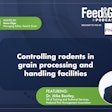
Leadership is more than just a job title — it’s a responsibility, a mindset and a daily practice rooted in purpose. It involves guiding others toward a shared vision, setting the tone for workplace culture and helping teams navigate challenges and opportunities.
Leadership is essential in every industry, and that’s especially true in feed and grain, where teams operate in high-stakes environments shaped by market volatility, seasonal pressure, regulatory complexity and the daily need for operational efficiency.
Strong leadership ensures not only business success but also employee well-being, customer satisfaction and long-term growth. This column explores the key characteristics of effective leaders and why communication is one of the most critical skills they must master.
Core characteristics of effective leaders
A leadership position doesn’t automatically make someone an effective leader. Holding a title such as manager, president or supervisor may confer authority, but true leadership is earned through actions, behaviors and values. Conversely, individuals without formal authority often lead in meaningful ways by setting examples, building consensus or contributing ideas that drive change.
Let’s explore 12 core traits commonly found in admired, effective leaders across the feed and grain industry and beyond:
- Integrity: Integrity is the bedrock of leadership. Leaders who are honest, ethical and consistent in their decisions earn the trust and loyalty of those they lead. A high-integrity workplace encourages people to speak up, take initiative and work collaboratively without fear of blame.
- Vision: Great leaders look beyond day-to-day operations and articulate a compelling picture of the future. A strong vision helps teams understand where the organization is headed and why their work matters. This sense of purpose is crucial during times of uncertainty or change.
- Empathy: Empathetic leaders seek to understand the needs, perspectives and challenges of their teams. This human connection builds trust, boosts morale and creates a culture where people feel seen and supported.
- Decisiveness: Leadership requires making timely decisions, often with limited information. Decisive leaders evaluate options quickly, take responsibility for outcomes and keep momentum moving forward. Indecisiveness, on the other hand, can stall progress and frustrate teams.
- Adaptability: In today’s fast-changing world, adaptability is essential. Leaders must be willing to embrace new technologies, modify plans and respond to evolving customer needs or regulatory pressures. Adaptable leaders are also more resilient in the face of setbacks.
- Accountability: Great leaders take ownership of their decisions and model accountability for their teams. They admit when things go wrong, learn from missteps and create a culture where people feel safe to take responsibility without fear of undue punishment.
- Commitment to growth: Leadership is not static. The best leaders are curious, open to feedback and committed to continuous learning. They also invest in developing others, mentoring rising talent and supporting skill building across the organization.
- Grit: Grit combines perseverance and passion for long-term goals. In feed and grain, where weather events, market shifts and supply chain disruptions can derail even the best-laid plans, grit helps leaders stay focused and motivated over the long haul.
- Humility: Humble leaders understand they don’t have all the answers. They welcome input, admit mistakes and share credit for successes. Humility fosters collaboration and creates space for others to lead from where they are.
- Strategic thinking: Strategic leaders go beyond reactive decision-making to anticipate challenges and position their teams for the future. They stay attuned to market trends, regulatory shifts, technology advances and customer needs, using that insight to shape long-term plans.
- Emotional Intelligence (EQ): High EQ helps leaders manage their own emotions and understand the feelings of others. This skill is invaluable during high-pressure situations, such as harvest, plant shutdowns or crisis response. Leaders with strong EQ defuse tension, maintain morale and guide teams with empathy.
- Communication: Clear, authentic communication connects vision to execution. It’s the thread that links people, strategy and culture. Leaders who communicate well foster alignment, minimize confusion and keep their teams engaged and informed.
Effective leadership communication
Leadership and communication go hand in hand. Leaders who speak with clarity, listen actively and express themselves authentically build trust and credibility. Communication is not just about sending emails or giving directions — it’s about connection, alignment and inspiration.
Here are four foundational elements of effective leadership communication:
- Clarity: Leaders must express themselves in a way that is easy to understand and free of jargon. Frequent and direct communication reduces confusion, aligns expectations and boosts productivity.
- Consistency: Repeating core messages helps reinforce values, strategy and organizational goals. Inconsistent communication can cause uncertainty and erode trust.
- Listening: The best communicators listen more than they speak. Active listening helps leaders surface concerns, gather insights and make more informed decisions.
- Empowerment: Communication should inform as well as inspire. Leaders use words to spark action, instill confidence and create a sense of ownership among team members.
Communicating in crisis
Crisis is the ultimate test of leadership. Whether it's a fire at the facility, a market collapse, a cybersecurity breach or a labor shortage, the way a leader communicates in difficult moments can define their effectiveness and shape the organization’s response.
Key principles of crisis communication include:
- Be transparent: Share what you know, what you don’t know and what you're doing to find answers. Even when the news is difficult, transparency builds trust.
- Act quickly and communicate often: Timely updates prevent rumors and misinformation. Even brief updates reassure teams that leaders are paying attention.
- Show empathy and reassure: Acknowledge the emotional impact of the crisis. Let people know you care and are committed to getting through it together.
- Stay visible and accessible: Leaders who remain present and approachable help stabilize morale and encourage open dialogue.
- Align words with actions: Teams quickly spot inconsistencies. Leaders must ensure their behavior matches their messaging.
- Plan for recovery: Once the immediate crisis is contained, communication should shift toward the future. What lessons were learned? What will change moving forward? A recovery plan provides direction and hope.
Putting leadership into practice
Leadership isn’t reserved for executives, managers or elected officials. It’s a daily choice — to act with integrity, communicate with intention and lead with empathy. Whether you’re managing a grain facility, coordinating logistics or training new staff, these core traits apply.
In an industry as dynamic and demanding as feed and grain, cultivating strong, adaptable and compassionate leadership at every level builds healthier teams, stronger businesses and more resilient communities. And as the challenges facing agriculture continue to evolve, the value of exceptional leadership has never been greater.

















